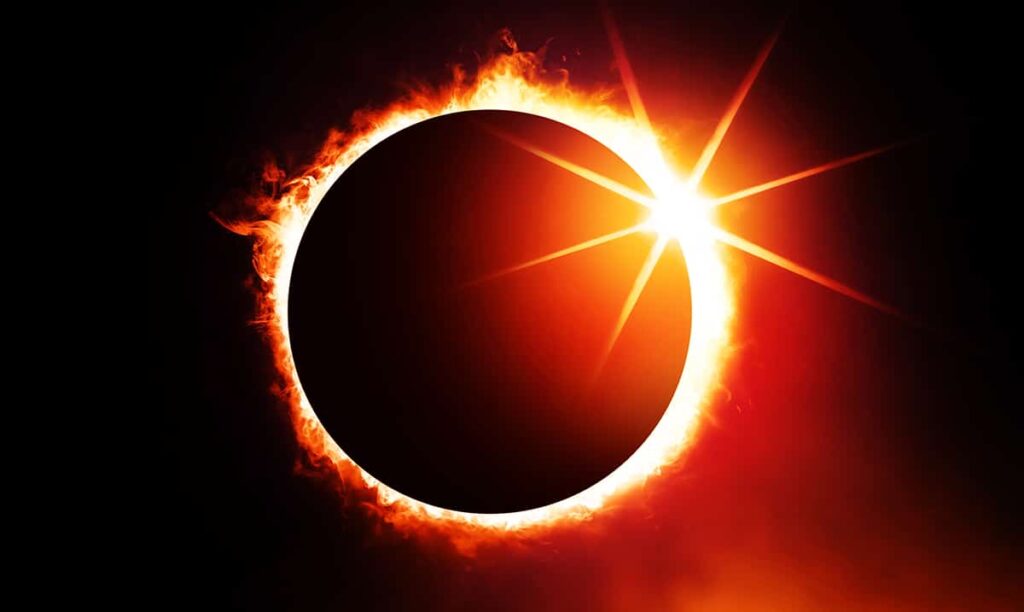As autumn sets in, the night sky welcomes star gazers with an array of captivating celestial events. From close encounters of the Moon with bright planets and stars, to a dramatic annular solar eclipse, October promises to be an exciting month for sky enthusiasts. Here’s a curated list of skywatching highlights for October, and some suggested tools for the best viewing experience.
October is set to be a stargazer’s dream with a mix of lunar phases, planetary conjunctions, and even a solar eclipse! Let’s dive into the specifics of each event:

solar eclipse on dark sky
Moon Meets the Pleiades (October 2-3)
The Pleiades star cluster, also known as the Seven Sisters, is a stunning sight in itself.
- October 2: After sunset, by 10 p.m., the Moon will appear super close to the Pleiades in the eastern sky, making for a scenic celestial pairing. This event can be best appreciated with the Celestial Field Binoculars, allowing you to take in the full beauty of the star cluster next to the Moon.
- October 3: As dawn approaches, shift your gaze to the southwest. The Moon will still be near the Pleiades but now accompanied by Jupiter and the fiery-red star Aldebaran in Taurus. A Dianfan Telescope Pro Telescope is ideal for a clearer view of this grouping.
For the perfect telescope for adults and children alike, click here.
Venus and Leo’s Heart (October 10)
Before the Sun rises, Venus will make a splendid appearance in the east, flanked by a slender crescent Moon.
- With the bluish-white star Regulus, the heart of Leo, positioned between them, it’s a perfect alignment that’s bound to fascinate. The Morning Star Guidebook provides insights into the phases and appearances of Venus throughout the year.
Annular Solar Eclipse (October 14)
One of October’s main events is the solar eclipse, where the Sun will turn into a dramatic “ring of fire”.
- The path of this annular eclipse starts in Southern Canada, goes through the Western U.S., and continues over Central and South America. Observers outside this path, but within the viewing zone, will still witness a partial eclipse.
- Safety first! Always remember to use Eclipse Viewing Glasses when observing any solar event to protect your eyes.
To get your own Eclipse Viewing Glasses – click here.
Lunar Phases (October 14 & 28)
Moon phases provide us with some of the most beautiful nightly views.
- October 14: New Moon. With the moon absent, this is a prime opportunity for stargazers to observe faint celestial bodies using the
- October 28: Full Moon. As it ascends, it brings along the mighty Jupiter, making it an unforgettable night with two of the brightest objects in the sky close together. Dive deep into the details with the Lunar and Planetary Handbook.
Moon and Saturn Conjunction (October 23-24)
Saturn, with its iconic rings, always makes for a delightful observation.
- October 23: The Moon, around 70% illuminated, will be located beneath Saturn. The proximity makes it an excellent opportunity for telescope viewing.
- October 24: The Moon moves to the east of Saturn. This pairing will again be a treat, so ensure your Planetary Telescope Kit is at hand for enhanced views.
To get your own telescope before all the fun begins, click here.
The “Ring of Fire” Solar Eclipse (October 14)
An annular solar eclipse, often termed a “Ring of Fire”, is one of the most mesmerizing astronomical events. Unlike a total solar eclipse, the moon doesn’t completely cover the Sun during an annular eclipse. Instead, the outer edge of the Sun remains visible, forming a blazing ring around the Moon.
When and Where to Watch:
- Path of Annularity: The path where the “Ring of Fire” will be most prominent begins in Southern Canada, traverses the Western U.S., and continues over Central and South America. Observers situated directly along this path will experience the full effect of the annular eclipse.
- Outside the Path: If you are not located directly within the path of annularity, don’t fret! Those within the broader viewing zone will still witness a captivating partial solar eclipse. The Moon will cover a part of the Sun, creating a crescent shape.
- Time: The exact time to watch the annular eclipse will vary depending on your location. Generally, it’s best to consult a local astronomical society or online resource tailored to your location for the precise time to catch this spectacle.
Safety and Viewing:
- Always Prioritize Safety: Never look directly at the Sun without proper eye protection, especially during an eclipse. Regular sunglasses, no matter how dark, are NOT safe for viewing the Sun.
- Eclipse Viewing Glasses: Ensure you have a pair of Eclipse Viewing Glasses. These glasses are specially designed with a solar filter to allow safe observation of the Sun.
- Telescopic Viewing: If you’re using a telescope, ensure it’s equipped with a Solar Filter. This allows for detailed and safe observations, letting you catch the finer details of the eclipse.
- To get your own eclipse glasses or a solar filter for your camera to get the perfect shot, click here or here.
With the right preparations and safety precautions, the “Ring of Fire” solar eclipse is bound to be a memorable experience. Don’t miss out on this unique opportunity to witness the mesmerizing dance between the Sun and Moon.
Eclipse Photography Kit, Glasses, and App for iPhone and Android, Safe for Viewing Celestial Phenomenon – click here.
Get ready for an action-packed month filled with celestial wonders. With the right tools and a clear night sky, October promises to be a month of unforgettable skywatching!

